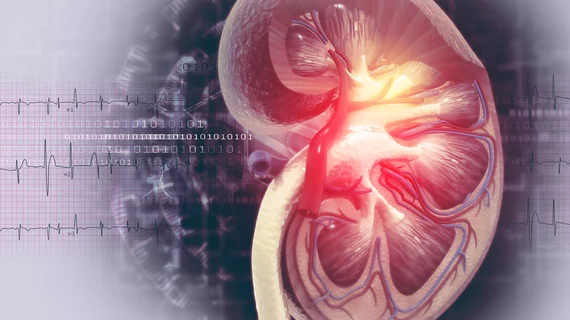Patients with chronic kidney disease (CKD) who undergo coronary revascularization experience fewer adverse events in the short term with PCI compared to coronary artery bypass grafting (CABG) but similar three-year risks of death, stroke or heart attack.
Gennaro Giustino, MD, and colleagues published these results in the Journal of the American College of Cardiology as part of a subgroup analysis from the EXCEL trial.
“Both PCI and CABG are thus acceptable revascularization approaches in selected high-risk patients with LMCAD (left main coronary artery disease) and CKD,” the authors concluded. “Individual patient comorbidities, the likelihood to safely obtain complete revascularization, and patient preferences as to the early benefits of PCI versus the late benefits of CABG should thus be factored into the heart team decision-making process in high-risk patients with LMCAD and CKD.”
The dangers associated with revascularization in patients for CKD likely explains why fewer of them receive the procedures, the authors noted. But they believe insights from this analysis—in the absence of randomized trial data—may help inform clinical decision-making for this high-risk population.
Out of 1,869 patients randomized to either PCI with Abbott’s XIENCE everolimus-eluting stent or CABG, 19.3 percent had CKD of stage 3 or worse.
About 21 percent of those patients with CKD experienced the composite primary endpoint of death, myocardial infarction (MI) or stroke at three years. That event rate was 60 percent higher than what was seen in patients without CKD (13.5 percent).
Acute renal failure (ARF) occurred within 30 days for 5 percent of patients in the CKD group and was associated with a 4.59-fold jump in meeting the primary endpoint at three years (50.7 percent for ARF; 14.4 percent without ARF).
Notably, ARF occurred in only 2.3 percent of CKD patients following PCI, but in 7.7 percent of them after CABG. However, the primary composite endpoint occurred in 23.4 percent of renal disease patients after PCI and in 18.1 percent after CABG, a nonsignificant difference.
“The lower rates of MI and revascularization during the follow-up period after CABG compared with PCI as initially described in EXCEL may have offset the deleterious effects of ARF and surgical complications in the CKD cohort,” Giustino et al. wrote, noting the short-term benefits of PCI also included reduced bleeding, need for transfusions and arrhythmias.
Unsurprisingly, progressively lower estimated glomerular filtration rate was associated with greater three years risks of all-cause mortality and the primary endpoint.
The majority of the patients in the study had moderate renal impairment. Therefore, the authors suggested the results of the analysis shouldn’t be extrapolated to a population with more severe CKD. Also, the patients had low to intermediate anatomical complexity, and results may differ in those with more extreme anatomy.
In a related editorial, Patrick T. O’Gara, MD, predicted most patients—if given this data—would choose PCI due to its lower risk of short-term complications. But additional steps must be taken to facilitate clinicians’ decisions and patient-centered conversations, he said.
Patient-level data on quality of life and functional outcomes could help in this regard, O’Gara said, along with extended follow-up. The EXCEL investigators plan to continue tracking their patients for two more years, or five total.
“The detailed findings presented here add to the evidence base regarding outcomes in CKD patients undergoing revascularization with either PCI or CABG,” wrote O’Gara, with Brigham and Women’s Hospital in Boston. “In the absence of a clear winner, they also accentuate the need for longer-term follow-up in trials of coronary revascularization and argue strongly for the promotion of efforts to utilize validated risk models to help guide difficult decisions.”

